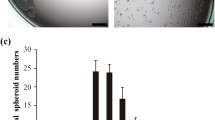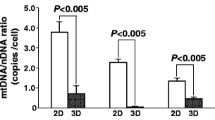Abstract
Advancements in cell cultures are occurring at a rapid pace, an important direction is culturing cells in 3D conditions. We demonstrate the usefulness of agarose hydrogels in obtaining 3 dimensional aggregates of three cell lines, A549, MCF-7 and Sp2/0. The differences in culture phases, susceptibility to cisplatin-induced cytotoxicity are studied. Also, the 3D aggregates of the three cell lines were reverted into 2D cultures and the protein profile differences among the 2D, 3D and revert cultures were studied. The analysis of protein profile differences using UniProt data base further augment the usefulness of agarose hydrogels for obtaining 3D cell cultures.




Similar content being viewed by others
References
Baker EL, Srivastava J, Yu D, Bonnecaze RT, Zaman MH (2011) Cancer cell migration: integrated roles of matrix mechanics and transforming potential. PLoS One 6:e20355. doi:10.1371/journal.pone.0020355
Bazou D (2010) Biochemical properties of encapsulated high density 3-D HepG2 aggregates formed in an ultrasound trap for application in hepatotoxicity studies: biochemical responses of encapsulated 3-D HepG2 aggregates. Cell Biol Toxicol 26:127–141
Berardi R, Morgese F, Onofri A, Mazzanti P, Pistelli M, Ballatore Z, Savini A, Lisa MD, Caramanti M, Rinaldi S, Pagliaretta S, Santoni M, Pierantoni C, Cascinu S (2013) Role of maspin in cancer. Clin Transl Med 2:8
Cella N, Contreras A, Latha K, Rosen JM, Zhang M (2006) Maspin is physically associated with b- integrin regulating cell adhesion in mammary epithelial cells. FASEB J 20:1510–1512
Chitcholtan K, Sykes HP, Evans JJ (2012) The resistance of intracellular mediators to doxorubicin and cisplatin are distinct in 3D and 2D endometrial cancer. J Transl Med 10:38
Cukierman E, Pankov R, Stevens DR, Yamada KM (2001) Taking cell-matrix adhesions to the third dimension. Science 29:1708–1712
Debnath J, Brugge JS (2005) Modeling glandular epithelial cancers in three-dimensional cultures. Nat Rev Cancer 5(9):675–688
DesRochers TM, Shamis Y, Alt-Holland A, Kudo Y, Takata T, Wang G, Jackson-Grusby L, Garlick JA (2012) The 3D tissue microenvironment modulates DNA methylation and E-cadherin expression in squamous cell carcinoma. Epi genetics 7:34–46
Fischbach C, Chen R, Matsumoto T, Schmelzle T, Brugge JS, Polverini PJ, Mooney DJ (2007) Engineering tumors with 3D scaffolds. Nat Methods 4:855–860
Harma V, Virtanen J, Makela R, Happonen A, Mpindi JP, Knuuttila M, Kohonen P, Lotjonen J, Kallioniemi O, Nees M (2010) A comprehensive panel of three-dimensional models for studies of prostate cancer growth, invasion and drug responses. PLoS One 5:e10431
Lai Y, Asthana A, Kisaalita WS (2011) Biomarkers for simplifying HTS 3D cell culture platforms for drug discovery: the case for cytokines. Drug Discov Today 16:293–297
Li S, Lao J, Chen PCB, Li YS, Zhao Y, Chu J, Chen KD, Tsou TC, Peck K, Chien S (2002) Genomic analysis of smooth muscle cells in three- dimensional collagen matrix. FASEB J 17:97–99
Longati P, Jia X, Eimer J, Wagman A, Witt MR, Rehnmark S, Verbeke C, Toftgård R, Löhr M, Heuchel RL (2013) 3D pancreatic carcinoma spheroids induce amatrix-rich, chemoresistant phenotype offering a better model for drug testing. BMC Cancer 13:95
Meli L, Jordan ET, Clark DS, Linhardt RJ, Dordick JS (2012) Influence of a three-dimensional, microarray environment on human cell culture in drug screening systems. Biomaterials 33:9087–9096
Owen SC, Shoichet MS (2010) Design of three-dimensional biomimetic scaffolds. J Biomed Mater Res, Part A 94A:1321–1331
Pampaloni F, Reynaud EG, Stelzer EHK (2007) The third dimension bridges the gap between cell culture and live tissue. Nat Rev Mol Cell Biol 8:839–845
Pampaloni F, Stelzer EHK (2009) Three-dimensional cell cultures in toxicology. Biotechnol Genet Eng Rev 26:117–138
Ravi M, Sah S, Bhammar R (2014) Differences of siha (human cancer of cervix) and BMG-1 (brain glioma) cell lines as 2D and 3D cultures. J Cell Physiol 229:127–131
Ross DT, Scherf U, Eisen MB, Perou CM, Rees C, Spellman P, et al (2000) Systematic variation in gene expression patterns in human cancer cell lines. Nat Genet 24:227–35
Stockinger A, Eger A, Wolf J, Beug H, Foisner R (2001) E-cadherin regulates cell growth by modulating proliferation-dependent b-catenin transcriptional activity. J Cell Biol 154:1185–1196
Vidi PA, Bissell MJ, Lelièvre SA (2013) Three-dimensional culture of human breast epithelial cells: the how and the why. Methods Mol Biol 945:193–219
Wozniak MA, Modzelewska K, Kwong L, Keely PJ (2004) Focal adhesion regulation of cell behaviour. Biochim Biophys Acta 1692:103–119
Xu T, Molnar P, Gregory C, Das M (2009) Electrophysiological characterization of embryonic hippocampal neurons cultured in a 3D collagen hydrogel. Biomaterials 30:4377–4383
Zschenker O, Streichert T, Hehlgans S, Cordes N (2012) Genome-wide gene expression analysis in cancer cells reveals 3D growth to affect ECM and processes associated with cell adhesion but not DNA repair. PLoS One 7:e34279. doi:10.1371/journal.pone.0034279
Acknowledgments
We acknowledge the help of Dr. Ganesh Venkatraman, Dr. Suresh Kumar Rayala for their suggestions and Mr. Hemdev along with Mr. Anirudh for helping us with the cell lines and the SDS PAGE analysis.
Author information
Authors and Affiliations
Corresponding author
Rights and permissions
About this article
Cite this article
Ravi, M., Kaviya, S.R. & Paramesh, V. Culture phases, cytotoxicity and protein expressions of agarose hydrogel induced Sp2/0, A549, MCF-7 cell line 3D cultures. Cytotechnology 68, 429–441 (2016). https://doi.org/10.1007/s10616-014-9795-z
Received:
Accepted:
Published:
Issue Date:
DOI: https://doi.org/10.1007/s10616-014-9795-z




